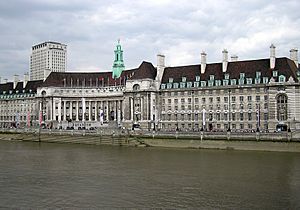Fares Fair facts for kids
Fares Fair was a plan by the Greater London Council (GLC) in London to make public transport cheaper. The GLC was led by Ken Livingstone at the time. This plan was put into action in 1981. It aimed to lower the cost of bus and London Underground (Tube) tickets. However, a court later decided the plan was against the law, and it had to be stopped in 1982.
Many members of the Labour Party in London supported Fares Fair. They thought it was a good and fair idea. They had not considered if it might be illegal. In the 1981 GLC election, Labour won. They had promised to make fares cheaper in their election plan. So, in October 1981, they cut London Transport fares by about one-third.
Soon after, a man named Dennis Barkway challenged the plan. He was a leader from the Bromley London Borough Council. He took the GLC to court. Barkway argued that people in London Borough of Bromley had to pay more taxes for the London Underground, even though the Tube did not go through their area.
Why the Plan Started
In the 1970s, a city called Sheffield had a very successful plan for its buses. The leader, David Blunkett, made bus tickets very cheap. Buses also came very often, about every five minutes. This meant most people in Sheffield chose to take the bus instead of driving their cars. Because fewer cars were on the roads, buses could move around easily. London's Labour council wanted to do something similar.
In 1979, the Labour government lost the election. A new Conservative government, led by Margaret Thatcher, took over. This new government wanted to cut down on spending. They decided to cut money for things like housing, education, and social services. These services were mostly run by local councils, not the main government. The government also believed that public transport should not need extra money from taxes.
The government introduced a new system to estimate how much money each local council needed. If a council spent more than this amount, local people would have to pay a bigger share of the extra cost. The government hoped this would make councils spend less.
How Fares Fair Began
In 1981, the Labour Party's plan for the GLC was to make fares cheaper on all London Buses and London Underground services. This would cut fares by about one-third. To pay for this, the GLC planned to increase local taxes by 5%. The main government stopped the GLC from giving money to British Rail services. So, the plan only covered buses and the London Underground.
The GLC had already sent out tax bills for 1981. So, to get the extra money, they sent out another tax bill. This meant people could clearly see how much the cheaper fares were costing them in extra taxes.
Once the Fares Fair plan started, people traveling around London enjoyed much cheaper bus and Tube rides. The GLC intended for wealthier people to pay more in taxes to help cover the transport costs for poorer residents.
The Legal Challenge
In late 1981, the Conservative-led Bromley London Borough Council challenged the "Fares Fair" plan in court. Their challenge focused on three main points:
- People in Bromley had to pay extra taxes for the London Underground, even though there were no Tube stations in Bromley.
- Wealthier taxpayers were not only helping poorer residents but also people who traveled into London from outside the city. These people benefited from cheaper fares but did not pay the extra taxes. Bromley Council argued that Ken Livingstone was not acting in the best interest of all London taxpayers.
- The plan went against the government's idea that public transport should pay for itself.
Bromley Council also challenged London Transport itself. They argued that London Transport had no right to lower fares using money from an illegal plan.
The court decided that the GLC's Fares Fair plan was illegal. The court agreed with all the reasons given by Bromley Council. The GLC had to stop the plan. The extra tax bills sent out by the GLC were also declared invalid. This meant people did not have to pay them, and the GLC had to give money back to anyone who had already paid.
London Transport was also told that lowering fares was illegal because it depended on money from an unlawful plan. So, fares had to go back up to a level where buses and the Tube could pay for themselves.
As a direct result, bus and Tube fares became much more expensive than they were before the Fares Fair plan. This was because London Transport had to make up for the money it expected to get from the GLC but no longer would.
Images for kids



